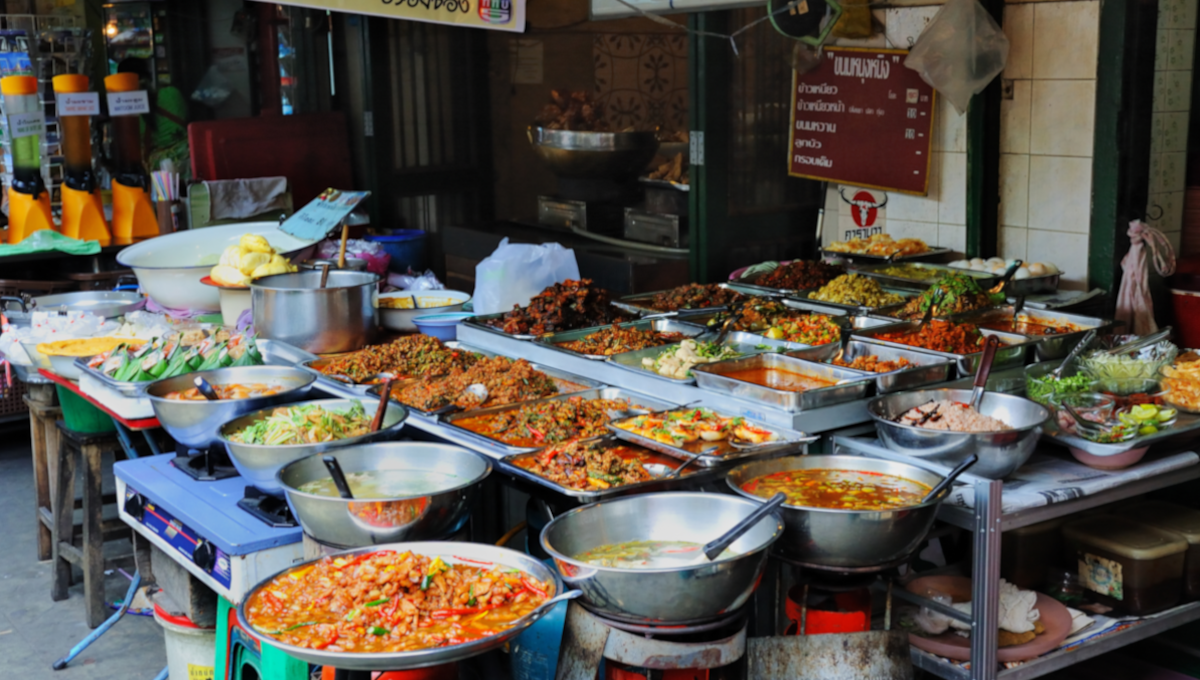/cdn.vox-cdn.com/uploads/chorus_image/image/73988223/cpkonfilm_54.0.jpg)
Situated on Beverly Drive, just blocks from Rodeo Drive and the Golden Triangle, the Beverly Hills California Pizza Kitchen is the first restaurant of the enduring chain , which now has locations across the globe. Opened in 1985 by Rick Rosenfield and Larry Flax, the Beverly Hills location — and more broadly, the California Pizza Kitchen brand — just celebrated its 40th birthday on March 27. California Pizza Kitchen, or CPK for short, was born in the era of Beverly Hills power lunches, where movers and shakers would slip out of the office, briefcase in hand, and settle in for a mid-day meal that doesn’t come close to resembling the desk lunches of today.
Although the restaurant has evolved in some ways, the menu and interior still spiritually feel like a time capsule of the ’80s and early ’90s. Tile in CPK’s signature shade of yellow wraps around the pizza oven, which roars with flames as pies slide in and out, crusts puffing up from the heat. A 40th birthday special of $9 take-home pizzas is hand-written on a black chalkboard.

Families with young children sit flanked on one side of the room. Although CPK was founded in Beverly Hills, it became a suburban American fixture over the years, taking up anchors at malls across the country where families would flock for affordable Barbecue Chicken pizzas, crispy avocado egg rolls, and grape-dotted Waldorf salads. Although the mall restaurant has declined over the years, CPK has persevered.
Maybe it’s a product of early-aughts chain nostalgia or the approachable menu translating to diners around the world. Still, as the chain turns 40, it has locations across the U.S.
and in countries like South Korea, Japan, Dubai, and Mexico. On the precipice of this milestone, CPK has seemingly entered its mid-life crisis era, when, during the week of March 22, 2025, it posted a video on Instagram that suggested the restaurant will rebrand to be a little more Charli XCX — the start of a “Brat” spring. Gone was the approachable black palm tree set against a yellow triangle, replaced by a three-dimensional metal-textured tree that resembles an NFT and a new tagline of “Fresh to Death.
” Brands like Ritz Crackers chimed in, writing “rizz detected” in the comments section, while other commenters mostly expressed confusion over the sudden change. Although this mid-life crisis feels somewhat engineered, there are questions surrounding the future of CPK as it wraps its fourth decade. Five Eater editors walked into the original Beverly Hills location for dinner on March 25, 2025, to discuss the future of the pizza chain as it looks to its 40th year and beyond.
—Rebecca Roland Kat Thompson, Eater at Home Associate Editor (KT): A friend with whom I grew up had a parent who worked in research and development at CPK. When we were broke high schoolers, we would get meals here, and, honestly, she helped to expand my palate when I was 14 because we were — I was — trying the entire menu. I always tell her that I feel like I got into my food career because I was doing suburban food tasting with her at CPK — she had some sort of membership card, so she would always get free meals.
I really want to write a story about how impactful CPK was for my early career development because it reminds me of that woman who did Olive Garden food reviews in her small town, and everyone made fun of her . But then, Anthony Bourdain was like, this is kind of cool because she’s reviewing what’s in her town and immediately available to her . Not to say that only CPK was available to me, but also when you grow up in like the suburbs, or in the Valley.
.. I was just hanging out at the Arcadia mall, the only place I wanted to be.
Matthew Kang, Lead Editor, Eater, Southern California/Southwest (MK): Three of us grew up in LA somewhere, and at the end of the day, for us, going to CPK as a kid or teen was still somewhere we were adventuring to. We live in a big city, we’re not old enough to drive ourselves yet — our parents are the ones driving us somewhere. I mean, that’s what it was like: For me, I was either going out in Glendale or K-Town.
Who’s going to Santa Monica? I didn’t know where to go. I didn’t even eat in Silver Lake, even though it was fairly close to me. Rebecca Roland, Editor, Eater, Southern California/Southwest (RR): Okay, I remember having really good buttered noodles here as a kid.
They had exceptional buttered noodles and use, like, really good butter. I always get made fun of when I say “California Pizza Kitchen.” Apparently, it comes out in the worst California accent.
Eater LA photographer Wonho Frank Lee arrives, snapping a flash with his now vintage Canon Powershot point-and-shoot camera. MK: Paparazzi’s here. KT: I mean, when I was 13 and 14, I was already interested in food at that time, so it was delightful to me to come here and say, “Okay, I’m gonna get the Chicken Tequila Fettuccine.
” I feel like I had capers for the first time here in the Chicken Piccata. A platter of four different kinds of tortilla rolls lands on the table along with a large bowl of Waldorf Chicken Salad, which just came back as part of CPK’s 40th Anniversary menu. RR: The Waldorf Chicken Salad used to be one of the most requested items for my table when I grew up in the Valley.
There’s apples and grapes — it’s fresh and it’s bright, and you get those crunchy celery pieces and the sweet candied walnuts. Nicole Adlman, Cities manager (NA): It is generously dressed. That’s the vibe here, and at most chain restaurants — borderline maximalist in terms of the size of the food that comes to the table, the amount of dressing put on the salad.
It’s very generous. MK: I think the essence of why we’re here is that there’s something that resonates about CPK that we can appreciate. I don’t think we would do this for another chain like Red Lobster or Applebee’s or even Chili’s.
It’s not that they’re bad, but there’s something that’s more special about CPK — that’s maybe not In-N-Out cool, but more accessible. Or it’s something about the intense nostalgia that makes it resonate in a different way for Angelenos. Wonho Frank Lee, Staff photographer (WFL): I think there are definitely a few places that resonate, right? Whatever that is, we grew up with it.
As a family, we would go there lot. In college, you would go there a lot. I think about California Chicken Cafe all the time — they feel very local, but also there’s a lot of them, so it’s a chain restaurant experience, too.
KT: CPK is always a very nostalgic experience, even eating this right now. It just reminds me of being a child, but in a nice way. MK: There are a lot of chain restaurants that feel like they have no roots.
The Cheesecake Factory was born in Beverly Hills, but it could have been from anywhere: It could have been from New York. It could have been from Texas. That’s what most chains want to be — something that could be from anywhere to appeal to the masses.
But CPK always felt very Los Angeles; like, no one would think this restaurant started in Northern California. It always felt like a restaurant that was very LA. “California was such a far-away idea.
It was such an ethereal dreamland that wasn’t real to me as a kid on the other side of the country.” NA: I think that speaks to when CPK first started because the founders wanted to do Spago — but make it TGI Fridays. I think the genesis was kind of like, “Can we make something accessible that gives the feeling of what eating a pizza at Spago feels like?” So maybe it’s that inherent LA-ness that we can clock and see, while maybe others can’t.
I don’t think it’s just about “California” being in the name, about the branding. It feels like a chain that was born in LA. I want to say, from my perspective as someone who grew up on the East Coast, California was such a far-away idea.
It was such an ethereal dreamland that wasn’t real to me as a kid on the other side of the country. So when I first went to CPK, it was kind of like, “Oh! Avocado can be in egg rolls.” There is something green on every plate, green on the table.
I grew up eating takeout from the local Chinese joint, pizza from the local slice joints. CPK was where we would get avocado in an egg roll or affordably have a heaping green salad or lettuce wraps, or something like that. And so that, to me, was exposure to this ethereal other land.
RR: It also feels so ’90s Beverly Hills power lunch. But most people have never had a Beverly Hills power lunch. It’s a very aspirational activity — the California pastime of stepping out and going to lunch: Like fully leaving the office, going to a restaurant, and ordering a Waldorf salad.
The revived Rosemary Chicken and Potato Pizza (on gluten-free cauliflower crust) and the new Burnt Ends Barbecue Pizza (on a hand-tossed crust) arrive to the table. KT: It’s kind of incredible how well the cauliflower crust bends. And there’s no, like, mealiness to it at all.
NA: I’m in love. But there are like three other gluten-free pizzas coming, so I need to pace myself. RR: I think the burnt ends pizza tastes better than the Barbecue Chicken Pizza.
It’s just better. NA: Okay, strong statement. Matt, do you agree? MK: I’m trying to figure it out right now.
All they did was essentially swap out barbecue chicken with burnt ends, which will always be better than chicken. It’s literally impossible for chicken to beat this. You can give me the best barbecue chicken in the world and the worst burnt ends in the world and the burnt ends will still be better.
RR: I’m not the biggest barbecue chicken fan, so I would take this over the chicken. KT: Same. Well, I just don’t really like barbecue sauce.
MK: We should just ask for a whole plate of burnt ends. Also, who came up with avocado egg rolls? And why did every chain restaurant adopt them? KT: I don’t know because I feel like I was eating them at BJ’s, too. At CPK it’s like an avocado club, at BJ’s it’s more just like straight-up avocado in there.
“You can give me the best barbecue chicken in the world and the worst burnt ends in the world and the burnt ends will still be better.” MK: Not to turn the conversation, but can we talk about the aesthetics, like the sort of visual experience and tactile experience of being in a CPK? What does that mean for everyone here? NA: I think in my vaguest memory of those times I went to California Pizza Kitchen as a kid, it’s always this dim. I feel like I have a black veil over my face.
The mood lighting in here is very potent, and I don’t know if that is the sort of atmosphere they’re trying to create. Truly, the mood lighting in here, for me, is probably the most memorable visual aspect of it. Just how dim and faux jazz bar it is in a way? KT: I feel the opposite because the CPK I went to was in a mall that is very bright, and it partially juts out onto the mall floor.
To me, the aesthetic has always been Mall Gourmet. The vibe in my memory is just very mall. RR: When they renovated my childhood mall and made it into a fancy mall, they installed this upscale food section in the center with a new CPK, which had a patio that nudged into the mall.
MK: It’s like that Vegas feel. When I think about the era that this restaurant was born in, the ’80s, I think it hasn’t changed. Like the decor in here.
I feel like we could be in the ’80s, like, right now. From my vantage point, if I take away that flatscreen TV, this hasn’t changed in 40 years. I mean, even the music that’s like something on late-night TV from the early ’90s, you know.
[A sort of jam band-sounding song blares on the sound system.] They’re teasing an anniversary rebrand on Instagram, and Busy Philipps already has a reaction video about it. But clearly, they are not trying to make it seem too real.
Because it’s clearly not. They’re not going to rebrand and redesign all the restaurants. They’re not going to have this black-and-white ultra modern branding.
I think, in a way, they’re better off playing on nostalgia and that feeling of what it was like for us to grow up in these restaurants. Not only do we appreciate that, but also younger generations do, too. KT: Yeah, they love shit like this.
That’s why Chili’s has taken off on TikTok, and Chili’s has run with it . And compared to the higher prices of fast-food chains these days, somewhere like Chili’s has a Triple Dipper for under $20 that is arguably a better value. MK: Well, it’s interesting because food culture has obviously changed.
From the year 2000 to around 2020, food culture was about local and artisanal. It was about chef-driven restaurants, those kinds of things. And now, maybe because of the uncertain economic times, uncertain political times, people are just like, “I want comfort.
” Like Laurel Grill, right? Like, that’s a new restaurant and yet it’s the opposite of innovative. NA: Our Lauren Grill scene report was a little chilling to me. I mean, it’s more than what you wrote about the popularity of restaurants like these being a recession indicator.
It’s unsettling that things have to be so normcore, so oversimplified, to be appealing because we are so unmoored by everything happening externally around us. Like hyper normcore is what we’re seeing trend right now for people to feel safe or comfortable. I’m not saying Laurel Grill isn’t good.
It seems very good. And this is just the kind of experience that people want when they go out right now. Six more pizzas arrive, including one Barbecue Chicken Pizza on a hand-tossed crust, and one Barbecue Chicken Pizza — pineapple added — on a gluten-free cauliflower crust.
MK: Everyone take a bite at the same time. What do we think about the Barbecue Chicken Pizza now? NA: Even without the pineapple, the pizza is incredibly sweet. But there is still that balancing element of the nutty Gouda, I guess, maybe some flavor from the cauliflower crust.
It doesn’t feel so sweet that I’m repelled by the sweetness. It’s just a bite of comfort for me. KT: This was never my favorite pizza here, even though I know it’s everyone else’s favorite pizza here.
It’s so sweet, but I like what the onion adds. MK: There’s something disarmingly good about this pizza because it’s so untraditional. Clearly a lot of people like the combination of the sweet barbecue sauce with the red onion — and the aromatics.
There’s the cilantro. I feel like this is the first pizza many people taste that isn’t delivery. It’s sit-down restaurant pizza.
It’s definitely California pizza. There’s an almost blandly sweet crust — no sourness, no real wheat complexity. The crust is just a vehicle for what’s on top.
In other pizzerias, like in a Neapolitan place — the crust is actually what you’re looking for. But for California-style pizza, the crust can be more bland, can be more of a supporting character to the blend of toppings. “I am not one to order anything Thai at a giant chain restaurant.
Yeah, that was not me. My mom, who is Thai, would be like, “What the fuck are you doing?” NA: I don’t think the culinary development team here has strong cultural ties to the flavors and ingredients they use, but I think they’ve made something that reflects Los Angeles. It’s getting out of the white tower of one traditional way to make pizza and creating something equally resonant with ingredients that point to other communities and foodways that matter in Los Angeles.
Like, CPK’s Tostada Pizza is a revival, but the fact that they’re doing what is essentially, um, almost tlayuda-like— MK: A bastardized tlayuda. NA: Yes, that. And it’s not exactly chaos cooking , but CPK does engage in a kind of playful flavor experimentation in a way that feels earnest, not vulturous.
RR: This tastes more like a Crunchwrap Supreme, doesn’t it? KT: I am not one to order anything Thai at a giant chain restaurant. Yeah, that was not me. My mom, who is Thai, would be like, “What the fuck are you doing?” But the Thai Chicken Pizza reminds me of a Vietnamese wrap, like a spring roll with the peanut dipping sauce.
I get what it’s alluding to. Do I think this is inherently Thai? No, but there are elements of it that, you could argue, feel Southeast Asian, like bean sprouts and cilantro. It’s not from Thai cooking.
But I feel like that is the vibe, and while the flavors might not be accurate, I think the intention is to be broadly global to be more unique. MK: Rick Rosenfield has an incredible curiosity and he loves good food. So, he wants to figure out how to make something that’s delicious — I think he has that impulse.
Rick and I talked about pizza and food for like two-plus hours, totally impromptu. We were at his pizzeria that was briefly open in the Palisades , and we were sitting out there, and we talked. I don’t think he was trying to say, in a savior-y way, “I’m going to take Thai flavors to the masses.
” But I think he tried, in a way maybe only an Angeleno could, to make these flavors seem more universal to people who don’t have frequent exposure or access to them. RR: The Thai Chicken Pizza does feel very LA to me. I feel like this could be on the menu at any LA all-day cafe menu, like a Joan’s on Third, or a California Chicken Cafe, or anything that does a chicken wrap situation.
If this was presented in those settings as a “Thai chicken wrap,” you’d be like, “Okay, yeah, that tastes good.” KT: The flavors in this feel more aligned with bánh mi or a spring roll to me than anything Thai. It’s kind of like an American spin on anything: The Tostada Pizza tastes like white people tacos — hardshell, lettuce, tomato.
And honestly it’s fire, the beans are pretty good. RR: I think if you came home from the bar after having some drinks, and this was in your fridge, you’d be so stoked. The cauliflower crust on the Tostada Pizza kind of eats like a tortilla, like a thick tortilla.
It really works. WFL: It’s easy for people to look down at chain restaurants. But I don’t think there are many restaurants that can survive as long as this.
There’s definitely something good in that, right? NA: There’s something to say about longevity of the people who work here . Starting here 16 years ago [like VP of culinary Paul Przybylski], 37 years ago [like corporate chef Juan Borrayo]..
. like, there are California Pizza Kitchen lifers. There must be a reason because they stayed through the Pepsi ownership.
They stayed through the GGC [Golden Gate Capital] sale and bankruptcy. And there’s a reason we keep coming back to it: again, that resonance — formative flavor memories. Maybe it is something about the aspects of Los Angeles that we see in CPK, and it’s fun to have that reflection live in a way where we can have a little bit of home in Vegas and Waikiki, or wherever, you know, it’s all over the world now, I think? RR: It’s funny to think of looking for a little bit of home in a CPK while traveling.
MK: The Tostada Pizza reminds me of school lunches and not in a good way. It’s not completely pleasant nostalgia for me, but I can see where you all are coming from because I do like my Taco Bell Mexican Pizzas. NA: I will say having a toddler has made me become a CPK fan again.
I now take my son to the Marina Del Rey location because it’s easy, it’s kid friendly — although they always try to seat us by the bathrooms. My son loves pizza, but I would say before introducing it to him I hadn’t stepped foot in a CPK in like 15 years or so? But now I’m here every other month because they have a kids’ menu and crayons. I look back, sometimes critically, at being in a dinner rotation of Cheesecake Factory, TGI Fridays, and Applebee’s every Friday night for the entirety of my childhood.
Like why couldn’t we go anywhere cool and new and, I don’t know, independent? But now I’m also a parent taking my 2-year-old to the Cheesecake Factory and CPK — far less frequently than when I went growing up, but enough that it’s a thing . Does anyone else have recent CPK memories outside of tonight? Or is it just like an airport thing? WFL: Chains never left my rotation to be honest. CPK was never really my thing, though.
But Cheesecake Factory, I used to go there a lot, and you know, Denny’s, IHOP, like hell, even California Chicken Cafe, I go there a lot. The food is good. Chain restaurants are a little bit better — readier for kids.
There’s so many nice restaurants that don’t have any changing tables. I know when I go to the bathroom in a CPK, there’s a changing table. I know there’s going to be a high chair.
MK: I don’t know if the one next to us is still open. There was one in South Bay Galleria, which is very close to me. But part of the reason why we don’t go that often is because my son is not really into Italian food.
Pizza, he’s not into yet. He wants like, basically, Japanese home cooking all the time. Broth, and tofu, and grilled salmon.
He literally wakes up, and says, “I want rice.” He wants umami. NA: Jealous.
.. MK: Yeah, but you know what? I just think he doesn’t like this food yet, but I think when he gets he gets older, he will.
There are a lot of great things to say about a place like CPK, but I think there’s also the other side, which is that there’s a basicness to it. And I don’t think there’s anything wrong with that, and we’ve decided to embrace it in American society, but usually my mentality is that I always want something more complex, more interesting. Desserts, including a flight of miniature butter cakes topped with different jams, arrive to the table.
MK: Wow, I’ve never had the butter cake here. You know what I think is cool about CPK? It’s that LA is now a pizza-loving city, where even outsiders look at Los Angeles and go “Wow” at its pizza scene. Even though there’s not one definitive style, places like California Pizza Kitchen have allowed LA to create and accept so many more different kinds of pizza.
NA: I think we love chain restaurants especially in the moment when we’re eating in a chain restaurant. We’re not going out for avocado egg rolls from the Cheesecake Factory every week, or saying Barbecue Chicken Pizza is the best pizza we’ve ever had. But in the space of being inside the chain restaurant, when you happen to end up here, however you end up here, it can be great.
It’s like the Severance effect: As soon as you — your Outie — leaves the chain restaurant, you’re not thinking about the chain restaurant, about the next time you’ll be back. But when you’re in it, you’re consumed by it, enthralled by it, however mysteriously. MK: What do you think CPK looks like in another 40 years? NA: Look like? Tesla robots serving us, for sure.
MK: Funny because they opened about a year after I was born, right? So, maybe we’ll have the same lifespan. Maybe I’m taking my grandchildren here. But also look at the decline of malls.
The market is not in a good place. People like eating casually, but they also love fast-food and the convenience of drive-thrus. RR: I do wonder how much prices have increased from, like, the early 2000s to now.
How much does it take to feed a family of four here? That will be a factor in its longevity, I think. NA: I think there’s always going to be revenge of the norm — people gravitating toward things that are familiar because everything else is on fire. So I do believe, at least for the near future, restaurants like CPK aren’t going anywhere.
But how do you continue to capture a younger, newer audience when part of your brand is staying the same to be nostalgic for an older generation? MK: Let’s talk about what they haven’t done. They haven’t done the hot honey pepperoni thing; they haven’t done the Quarter Sheets-style square pizza. There are so many things that they haven’t done just because they’re trending, and I think that’s somewhat surprising, but also reassuring.
They’re basically saying: We’re so good, we’re timeless. RR: I think the dishes I get at CPK don’t have the ROI to make by hand at home. When I really think of my home cooking, I think: How much will it cost to make this? How long will this take to make? How much fun am I going to have making this? A lot of the dishes here are never going to be a super fun home-cooking project for me.
It’s messy; it’s time-consuming. I would rather just come here. MK: Ultimately, pizza — the dish — is just so timeless.
I mean, I genuinely believe that the classic things we ate tonight tasted the same 40 years ago. For CPK, that’s a good thing. Sign up for our newsletter.
Check your inbox for a welcome email. Oops. Something went wrong.
Please enter a valid email and try again..














